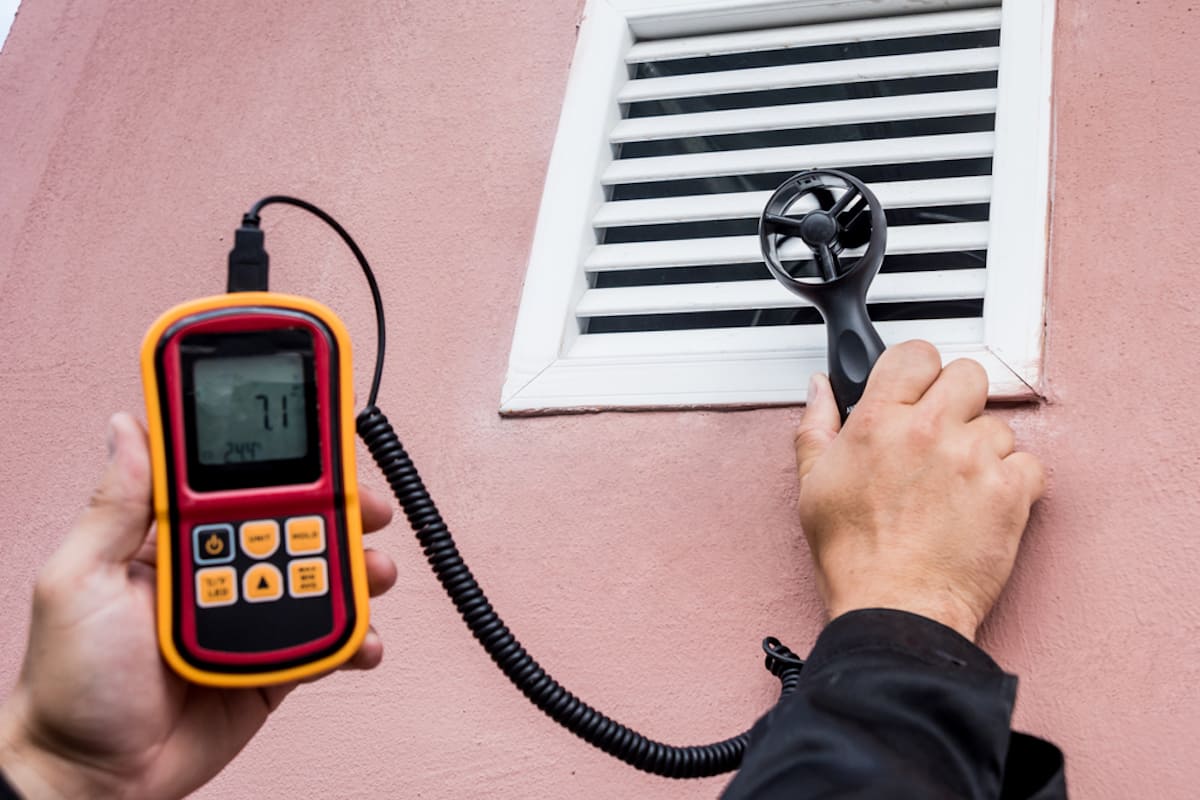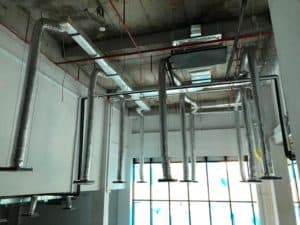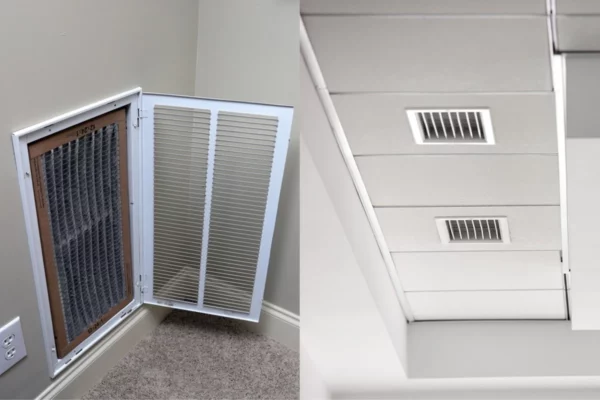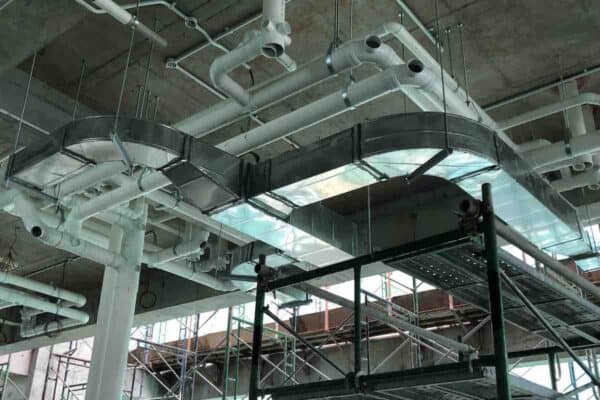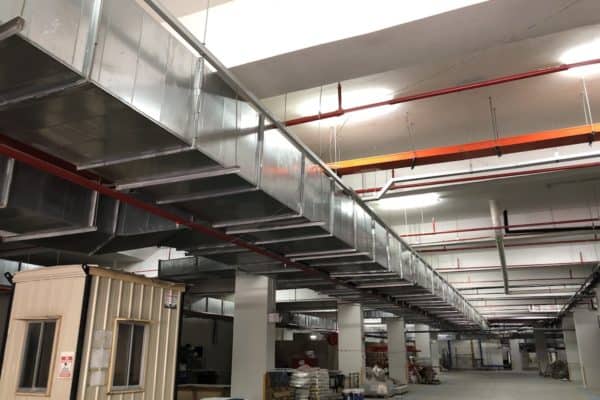How to Measure Airflow in HVAC? (Register & Duct)
Low airflow is a common problem in HVAC that lead to insufficient heating/cooling. Many people want to fix their HVAC by themselves to save money. But, they are not sure how to measure the airflow correctly. So, I think a guide on HVAC airflow measurement would be helpful.
To measure airflow in HVAC, place an anemometer near the register to get the air velocity reading. After that, measure the register neck size and calculate the neck area. Finally, multiply the air velocity by the register neck size to obtain the airflow of the register.
Measuring the airflow of HVAC units is not hard but it is tricky to get it done correctly. Incorrect airflow measurement will lead to an inaccurate diagnosis which can lead to a higher cost.
HVAC Airflow Basics
To learn how to correctly measure airflow in HVAC, we need to understand the basics of airflow. Following are some of the important things to know about the airflow measurement in HVAC:
Supply Airflow
Supply airflow is the total airflow of an HVAC unit (AC, furnace or fan). The total supply airflow of an HVAC unit is usually measured at the main outlet of the HVAC unit.
In addition, supply airflow also can be the airflow at each register (diffuser, grille or vent). All registers can have the same supply airflow but they most likely have a different supply airflow. The sum of the airflow at all registers is also the total supply airflow of the HVAC unit.
However, if the objective is to identify the total supply airflow of an HVAC unit, the airflow measurement should be taken place at the main outlet of the HVAC unit because calculating the total supply airflow by adding the airflow at each register is more prone to error.
But, if the objective is to troubleshoot heating/cooling problems in specific rooms, then the airflow of each register is more useful.
Return Airflow
Return airflow, ideally, is equivalent to the total supply airflow of an HVAC unit. By default, the return air duct should be as big as the supply air duct in most applications.
However, many HVAC units have a smaller return air duct relative to their supply air duct. Hence, the return airflow may be less than the supply airflow.
The return airflow of an HVAC unit is useful when troubleshooting insufficient heating/cooling problems.
Pressure Drop
Pressure drop is a technical term used in HVAC to represent the friction in the ductwork. Pressure drop can also be expressed as friction loss or static loss or pressure loss.
The higher the pressure drop, the lesser the airflow.
High pressure drop is most commonly caused by undersized ducts and registers. Besides, too many bends in ducts, too sharp of a bend in ducts and dirty filters also contribute to high pressure drop.
Air Balancing
Air balancing is an effort to balance the supply and return airflow of an HVAC system. Air balancing is essential for ducted air conditioning. Each register requires a specific airflow to ensure balanced heating/cooling in every room.
Unit of Measurement for Airflow
Airflow in HVAC can be expressed in different measurement units depending on regions and local practices. However, the following airflow measurement units are commonly used in HVAC:
- CFM – CFM stands for cubic feet per minute. CFM also can be expressed in ft3/min. CFM is the most commonly used unit of measurement for airflow in HVAC.
- m3/hr – m3/hr stands for cubic meter per hour. m3/hr also can be written as CMH. m3/hr is the second most common unit of measurement for airflow in HVAC, especially for people who use the SI unit. m3/hr is the official SI unit for airflow.
- L/s – L/s stands for litre per second. L/s also can be written as LPS. Sometimes, L/s is used as the unit of measurement for airflow in HVAC.
Airflow Unit Conversion Table
HVAC equipment are coming from different regions of the world. Hence, you may encounter an air conditioner that uses the SI unit even though you’re in a country where the Imperial unit dominates. So, the following is the unit conversion table for airflow:
| Primary Unit | Equivalent Unit |
|---|---|
| 1 CFM | 1.7 CMH |
| 1 CFM | 0.47 LPS |
| 1 CMH | 0.6 CFM |
| 1 CMH | 0.27 LPS |
| 1 LPS | 2.12 CFM |
| 1 LPS | 3.6 CMH |
HVAC Airflow Measurement Instruments
Instruments are needed to measure airflow in HVAC. Following are the 3 most commonly used instruments for airflow measurement in HVAC:
Anemometer
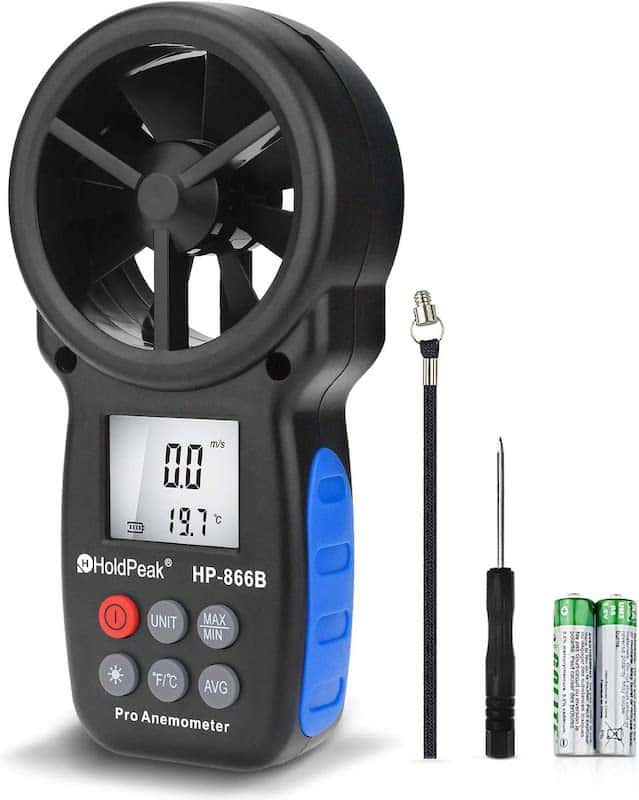
Anemometer is a small airflow measuring device that is used to measure air velocity. With an anemometer, you need to do manual calculations to convert from air velocity to air volume.
- Air Velocity is the speed of the airflow commonly expressed in feet per minute (FPM) for the Imperial unit and meter per second (m/s) for the SI unit.
- Air Volume is the airflow of the HVAC unit that we need which is expressed in either CFM, CMH or LPS.
To convert from air velocity to air volume, we need to multiply the air velocity by the respective area. For example, multiply the FPM by the duct area in square feet (sqft) to get the CFM.
An anemometer can come in several forms but for HVAC applications, we need one with a small fan attached to a display monitor. For instance, this anemometer on Amazon.
An anemometer requires you to physically hold and place it at the airflow outlet for a few seconds. Hence, it is more suitable for the airflow measurement at each register. It is not practical to use an anemometer to measure airflow inside the duct.
Pitot Tube
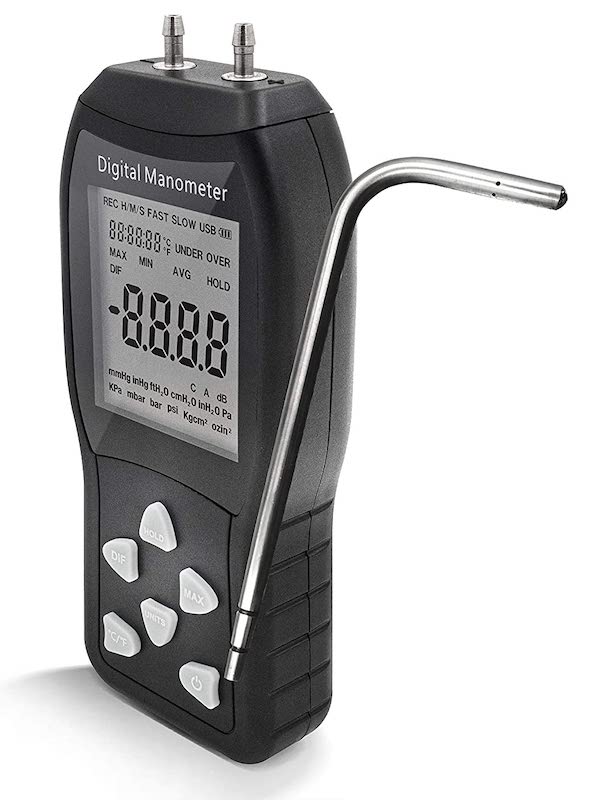
Pitot tube is a very common device for airflow measurement. Usually, the device comes with a pitot tube and a display monitor (called the manometer). The pitot tube measures the pressure and the display monitor converts it into airflow.
It takes a longer time to learn how to use a pitot tube correctly. However, it is easier and faster to use a pitot tube to measure airflow. But, pitot tubes are more expensive than anemometers.
A pitot tube is suitable for airflow measurement in ducts. Most of the time, you need to drill a few small holes in the duct for the pitot tube insertion. The holes can be conveniently sealed by rubber plugs.
It is rare for homeowners to use a pitot tube to troubleshoot their HVAC unit because it is costly and more challenging to use.
Flow Hood

Flow hood is a relatively big airflow measuring device usually used by HVAC professionals for extensive airflow measurement activities such as air balancing.
A flow hood is suitable for airflow measurement at each register. Instead of measuring the air velocity, a flow hood provides the air volume in terms of CFM, CMH or LPS.
Basically, a flow hood collects the total airflow of a register and uses a pitot tube to produce the airflow reading. It is very expensive to buy a flow hood and not practical for homeowners.
By the way, if you want to learn more about mini split especially how to design it for your house, consider my Mini Split (eBook). You’ll learn what is Mini Split, how to choose and more importantly, spark more design ideas to improve the energy efficient of your house. But, if you need a second opinion or want someone to help you design, then you can consider my consultation service.
Consultation Service
Ask me for HVAC advice such as brand selection, best model, benefits, features, placement, duct size, grille size, how to design, design check, verification and other HVAC related queries.
How to Measure Airflow at Register?
For homeowners and non-technical people, the most practical way to measure airflow for HVAC systems is using an anemometer. Although it involves manual calculations, it is the easiest and cheapest way to attempt to fix the HVAC unit.
1. Understand the Anemometer
Read the user manual of the anemometer and understand the icons and numbers displayed on the anemometer. Then, set the anemometer to either FPM or m/s depending on whether you’re using the Imperial unit or the SI unit.
2. Measure the Air Velocity at Each Supply Air Register
Place the anemometer close to the supply air register to measure the air velocity. Sometimes, the register may have a damper that can focus the airflow in one direction. If that’s the case, open up the damper fully and then measure the air velocity.
For better accuracy, measure the air velocity of the register at different points. For example, you can take 4 readings at each register at different points and get the average air velocity.
3. Identify the Neck Size of the Supply Air Register
After you took the air velocity reading, identify the neck size of the supply air register. The neck size is the duct size that connects the register.
Common register neck sizes are 6″ (150 mm), 8″ (200 mm), 10″ (250 mm) and 12″ (300 mm).
If the register is connected by a rectangular duct, measure the width and height of the duct.
Now, we need to convert the neck size into the form of the neck area. So, assume that the neck size is 8″, the neck area can be calculated as follow:
Neck Area = πr2
Neck Area = 3.142 x (8/2)2 ÷ 144
Neck Area = 0.35 sqft
Remember that the 8″ is the diameter and we need to divide it by 2 to get the radius for the formula. Then, we also need to convert it from inches to feet.
Similarly, if the neck size is 200 mm, the neck area in the SI unit can be calculated as follow:
Neck Area = πr2
Neck Area = 3.142 x (200/2)2 ÷ 10002
Neck Area = 0.0325 m2
Again, we need to divide 200 by 2 to get the radius and also convert it from millimeter into meter.
For rectangular ducts, simply multiply the height by the width of the duct to get the area in either sqft or m2.
4. Calculate the Airflow of the Register
Once you have the air velocity and the neck size, calculate the airflow of the register using the following formula:
Airflow = Air Velocity x Neck Size
where,
Airflow is expressed in either CFM or CMH
Air Velocity is expressed in either FPM or m/s
Neck Size is expressed in either sqft or m2
Now, assume that the air velocity measured is 500 FPM, the airflow of the register can be calculated as follow:
Airflow = Air Velocity x Neck Size
Airflow = 500 x 0.35
Airflow = 175 CFM
Similarly, if the air velocity measured is 2.54 m/s, the airflow of the register in the SI unit can be calculated as follow:
Airflow = Air Velocity x Neck Size
Airflow = 2.54 x 3600 x 0.0325
Airflow = 297 CMH
Since 1 CFM equals 1.7 CMH, the resulted 175 CFM in the Imperial unit is equivalent to the resulted 297 CMH in the SI unit.
5. Find the Total Supply Airflow
Now that you’ve done calculating the first register, proceed to measure all registers associated with the HVAC unit and then total up the airflow at each register to find the total supply airflow of the HVAC unit.
How to Measure Duct Airflow?
If you’re keen to get the airflow measurement as accurate as possible, you’ll need to use a pitot tube to measure the airflow straight at the supply air duct of the HVAC unit. This method requires you to drill a few small holes at the bottom of the duct.
Normally, we use a pitot tube to measure rigid rectangular metal ducts and rigid spiral round ducts. It is very difficult and inaccurate for the soft and flexible round ducts.
If your HVAC unit is using round flexible ducts for the main supply duct, you can take the airflow reading at the return air plenum box which usually is a rectangular metal duct.
1. Understand the Airflow Pattern in Duct
Directly measuring the airflow at the supply air outlet is more accurate but prone to error. So, the following rules must be followed:
- Take the airflow reading at a straight duct. If possible, allow about 6 ft (2 m) of straight length before your measurement point. The airflow result will be inaccurate if you measure it right after an elbow or a reducer.
- If you have no choice but to measure the airflow near a duct elbow, realize that most of the airflow will be concentrated at a side of the duct depending on the bend and thus, focus your measurement point around that region.
2. Prepare the Airflow Measurement Holes
It is inaccurate to measure airflow with just a single point. Instead, we need to take the average of multiple points in the duct.
For rectangular ducts, drill 3 holes in a line perpendicular to the direction of the airflow. For each hole, you’ll need to take 3 readings at 25%, 50% and 70% of the height of the duct. Hence, you’ll have a total of 9 airflow readings from 9 different points.
The below diagram illustrates the 9 airflow points in a duct:

For the drilling work, a battery hand drill with a metal bit will do the job.
Usually, the center of the duct (eg: point 5) will have the highest airflow because friction is present at the side of the duct.
For maximum accuracy, see the air velocity measurement guide by Dwyer here.
3. Measure the Airflow at Each Point
Now, insert the pitot tube with the intake hole against the airflow. Read the instruction manual to learn how to properly operate the pitot tube. If done right, the display monitor should indicate the airflow of each point in either CFM, CMH or LPS.
Once you have all 9 airflow readings, calculate the average airflow and compare it to the original airflow of the HVAC unit.
If the main duct is a round duct and you find it difficult to measure the airflow, proceed to measure the airflow at the return air plenum box with the same procedure.
After you’ve done measuring, use rubber plugs to seal the holes so that air won’t leak from there.
Final Thought
Low airflow in HVAC often is a complicated issue that you need a professional to help with. However, understanding how to measure airflow, especially at the register is useful for minor troubleshooting.
If your problem persisted, it could be the air balancing issue, the high static issue or others that need a professional to diagnose before making any conclusion so that the repair work is appropriate and precise.
Lastly, consider my Mini Split (eBook) if you want to know how can you use Mini Split in your house. If you still have doubt or not feeling confident enough, feel free to consult me.
Consultation Service
Ask me for HVAC advice such as brand selection, best model, benefits, features, placement, duct size, grille size, how to design, design check, verification and other HVAC related queries.
If you have anything to add (or ask) about this topic, leave a comment down below!


